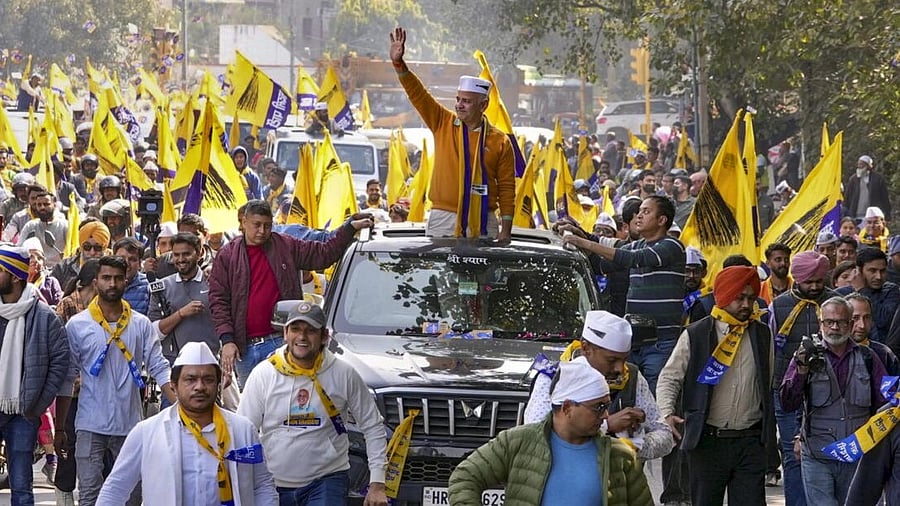
Campaign for Delhi polls.
Credit: PTI photo
The Bharatiya Janata Party (BJP)’s 27-year political vanvas in Delhi has finally come to an end. As the nation’s capital, Delhi commands national and global attention far beyond its size.
Following its electoral successes in Haryana and Maharashtra, the BJP has a stronger presence in Delhi. The Aam Aadmi Party (AAP) germinated through an ‘anti-corruption’ movement and rose fast enough to get a national party status. This leads to a crucial question: how did AAP, despite propagating its acclaimed ‘Delhi Model of Development’ and welfare policies like power and water subsidies, falter in this political showdown?
This election served as a litmus test for the politics of freebies. AAP created a ‘Free-Bijli, Free-Pani’ plank for the poor and migrants was staring at the biggest measure of their political existence. However, welfare politics appeared to have reached its saturation point.
With all three major parties offering a slew of freebies in their manifestos, AAP’s promises no longer held a distinct advantage. With the welfare being assured, voters began to ask, what’s next? This is where AAP’s governance model fell short. Across Delhi, frustrations over crumbling infrastructure grew louder, with many lamenting, ‘Nothing has improved in Delhi since Sheila Dikshit.’ The 12 years of anti-incumbency had caught on with AAP.
Despite AAP’s flurry of daily announcements — free bus rides for women, a monthly honorarium of ₹18,000 for temple priests and gurdwara granthis, and various sops for youth and students — these measures failed to resonate with voters.
Both the Congress and the BJP have a proven track record in developing Delhi’s infrastructure, unlike AAP, which had a golden opportunity to leverage the city’s ₹70,000 crore annual budget to upgrade its infrastructure. The situation had deteriorated to such an extent that just six months before the elections, the Delhi chief minister launched a ‘pothole-free’ drive. This made people reflect on what had changed on ground in 12 years.
This election marked a pivotal shift, as the electorate moved beyond traditional issues of religion, caste, and creed — or even the new political buzzword, ‘guarantees’ — to focus on urban governance and civic challenges. The inconvenient truths of Delhi like air pollution, the Yamuna’s pollution, the mountains of garbage in Bhalswa, Ghazipur, and Okhla, and deteriorating road conditions in residential colonies, became the centrepiece. Such that Congress leader Rahul Gandhi in his political rally brought Yamuna’s polluted water in a bottle and reminded Arvind Kejriwal of his unfulfilled promise of cleaning the Yamuna. Uttar Pradesh chief minister Yogi Adityanath challenged Kejriwal to take a dip in the Yamuna. On the defensive, Kejriwal accused Haryana of polluting the river, but by then, the election narrative had shifted decisively — from lofty political promises to the reality of governance on the ground.
When confronted with these questions, AAP resorted to its familiar refrain — the BJP-led Union government, through the lieutenant governor, does not let us work! But the intelligence of the voters cannot be underestimated. They recalled that between 1998 and 2004, despite the BJP governing at the Centre, Dikshit successfully delivered strong governance in Delhi without friction between the two opposing governments.
The election defeat also reflects the collapse of the political hope that AAP and Kejriwal once championed. Kejriwal’s rallying cry, ‘Hum Rajneeti Badalne Aaye Hain’ (‘We are here to change politics’), began to ring hollow as allegations like the liquor scam mounted against party leaders. Kejriwal refusal to resign as chief minister, was perceived as a sign of clinging to power — especially in contrast to leaders like JMM’s Hemant Soren, who stepped down as chief minister when imprisoned. This perception, compounded by the ‘Sheesh Mahal’ corruption charges, shattered Kejriwal’s carefully crafted image of being ‘Kattar Imaandar’ (extremely honest person).
When the public doesn’t witness tangible improvements in their surroundings, frustration with those in power quickly escalates. What starts as sparks of discontent can rapidly spread into a wildfire of dissent. The election referendum is against AAP and Kejriwal — with them losing over 12% vote share from 2020.
Many, especially minorities and weaker sections, felt betrayed by AAP’s response during critical moments like the 2020 Delhi riots and the anti-CAA movement. AAP’s dismissive stance, including remarks such as ‘Shaheen Bagh should be vacated in 24 hours’, further unmasked its ideology. Many AAP sympathisers became disillusioned over the years, with AAP’s ideological flip-flops.
This election has also proved that in India with such diverse layers, a politics of convenience, sans ideology, has limited shelf life. AAP may still govern Punjab, but with Delhi gone, its role in Indian politics, in the medium run, has significantly diminished.
This would be the time for AAP to go back to reflect on their ideological stand, and the politics choice they want to offer to the electorate.
(Rachit Seth is the founder of Policy Briefcase, and Aakash Mehrotra is a development consultant.)
Disclaimer: The views expressed above are the author's own. They do not necessarily reflect the views of DH.
